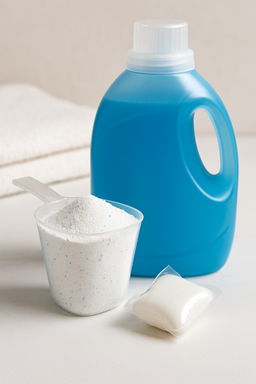Choosing the right laundry detergent can make a bigger difference than most people realize. The type you use affects stain removal, color brightness, fabric longevity, and even the smell of your washer. Unfortunately, detergent is also one of the most commonly misused laundry products — especially when it comes to dosing.
This guide breaks down everything you need to know so you can wash smarter, not harder.
1. Liquid, Powder, or Pods? Here’s How to Choose
Before you can think about how much detergent to use, you first need to choose the right type of detergent. Each option works differently, and understanding the strengths of liquid, powder, and pods will help you match the right product to your laundry goals. Below is a breakdown of how each form performs, what it’s best used for, and when to avoid it.
✅ Liquid Detergent (Best all-around)
Great for pre-treating stains
Dissolves well in any water temperature
Works with HE washers
Can be messy or over-poured
✅ Powder Detergent (Best for brightening + outdoor stains)
Excellent for mud, clay, and grass
More affordable
May not dissolve in cold water
Can clump in hard water
✅ Pods / Pacs (Best for convenience)
No measuring
Perfect for avoiding overuse
Less control over dosage
Not ideal for small loads
2. What Is HE Detergent — and Do You Need It?
Modern washers are designed to use far less water than older models, which means detergent has to be formulated differently to work properly. If you’ve ever wondered what “HE” really means or why certain detergents create too many suds — this section explains it simply so you can match the right detergent to the right machine.
✅ Why HE (High Efficiency) detergent matters
Designed for low-water washing
Cleans quickly
Low-sudsing to prevent buildup
Prevents moldy washer smells
Using regular detergent in an HE washer causes excess suds, residue, and odor — and can even reduce your washer’s lifespan.
3. How Much Detergent You ACTUALLY Need
Most people use way too much detergent, and that’s actually the #1 reason laundry comes out smelly, stiff, or still dirty. Detergent is powerful — and washers rinse better with less of it. Before reaching for another scoop or capful, here’s the dosing guidance experts recommend.
✅ General dosing rules
HE machine: 1–2 tablespoons liquid detergent
Standard machine: 2–3 tablespoons
Pods: 1 for normal loads, 2 for very large loads
✅ Signs you're using too much
Musty or sour odors
Stiff or sticky fabric
White streaks or residue
Washer smells bad
Towels that never feel “clean”
4. What About Hard Water? (Most of Southern California Has It)
If you’ve noticed your clothes look dull, feel stiff, or don’t smell fresh — your water might be the reason. Hard water reduces detergent effectiveness and leads to buildup in your washer. This section explains how to adjust your routine if you live in a hard-water area like Corona, Perris, or Riverside.
✅ Hard water adjustments
Use slightly more detergent (but not double)
Prefer liquid or pods over powder
Add a water-softening booster when needed
Deep-clean the washer more often
Hard water can also make it tougher to remove odor from athletic wear — oxygen boosters help tremendously.
5. Enzyme Detergents vs. Sensitive-Skin Formulas
Not all detergents are built the same. Some are designed for stain removal, while others prioritize skin sensitivity and gentleness. If you’ve ever wondered whether you should buy enzymes, fragrance-free formulas, or detergents labeled “sensitive,” this section helps you pick the right one.
✅ Enzyme Detergents
Best for active families or stain-prone laundry.
✅ Sensitive-Skin Detergents
Perfect for babies, eczema, or anyone irritated by fragrances.
6. Should You Use Fabric Softener? (Maybe Not)
Fabric softener is popular for making clothes feel smooth and smell great — but it comes with downsides many people don’t know about. Before using it out of habit, it’s important to understand where fabric softener helps and where it actually causes damage.
✅ Why you might skip fabric softener
Reduces towel absorbency
Leaves residue
Coats athletic wear
Can cause skin irritation
✅ Better alternatives
Vinegar in the rinse cycle
Wool dryer balls
Air-drying for delicates
7. When to Add Boosters (OxiClean, Baking Soda, Vinegar)
Detergent alone isn’t always enough — especially for odors, dull whites, or heavily soiled loads. Laundry boosters can elevate your wash performance without adding harsh chemicals. This section explains what each booster does best so you can choose the right one for each load.
✅ Oxygen bleach (Oxi-type products)
Brightens whites
Removes musty smells
Deep-cleans fabric
✅ Baking soda
Neutralizes odors
Softens fabric
Balances pH
✅ White vinegar
Natural fabric softener
Helps remove detergent residue
8. Common Detergent Mistakes to Avoid
Even seasoned laundry-doers make mistakes that reduce washing performance over time. This section highlights the most common detergent-related pitfalls — and how to fix them instantly.
✅ Common mistakes
Overusing detergent
Adding pods to tiny loads
Mixing bleach improperly
Using powder in cold cycles
Letting residue build up in dispensers
✅ Let Soapbox Laundry Room Handle the Laundry for You!
Not sure which detergent to choose? We handle everything — proper dosing, stain treatment, water-temperature settings, and expert wash techniques for every fabric.
👉 Schedule your pickup today:
https://www.soapboxlr.com/

Join The Discussion!